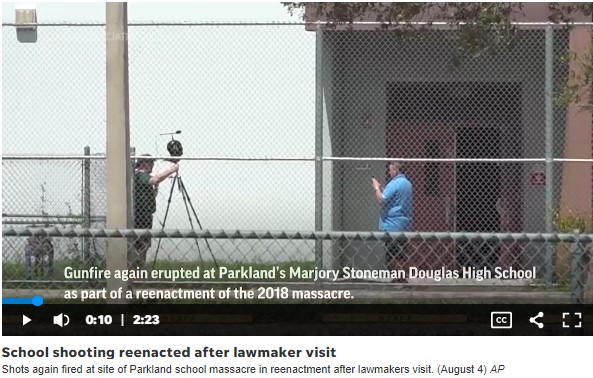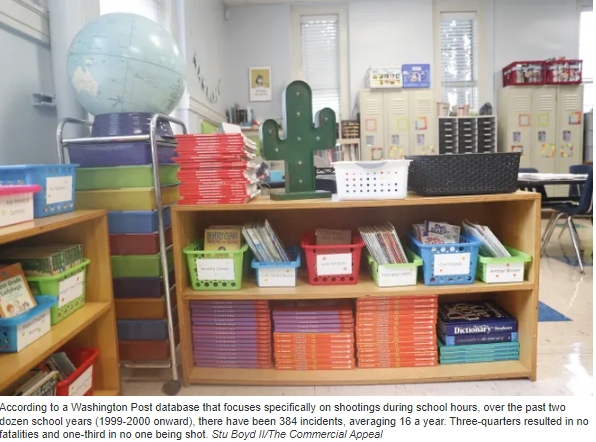Main|Bio|Books|USA Today columns|Opeds|Boston.com blog|Media|Other Publications| Speaking|Links

As students head back to school, should parents worry about shootings? The math says no.
Students and parents are worried about mass shootings as the school year begins. But the math says indiscriminate shootings aren't as common as we think.James Alan Fox Opinion contributor
Published 5:09 a.m. Aug. 8, 2023

The new school year is suddenly here. Students and their parents are heading off to local stores to stock up on school supplies. Meanwhile, ongoing news stories linked to the despicable acts of dispirited assailants from Nashville, Tennessee, Uvalde, Texas, and Oxford, Michigan, who targeted their local school provide no summertime respite from thinking - and worrying - about school shootings.
By most any measure, fears concerning school safety are running high. An NPR/PBS NewsHour/Marist national survey from May found that 40% of respondents felt that schools in their community were unsafe with regard to the risk of gun violence, up from 30% in 2019.
Moreover, according to last year's Gallup polling, 44% of parents feared for their childís safety at school, the highest level since the mass shooting at Columbine High School in April 1999. And 20% of these parents indicated that their child had expressed such concerns, a level only exceeded back in 2001.
Anxiety over the threat of school shootings is understandable given the loss of young lives, the massive media attention afforded these extraordinary crimes, and the unease that many parents experience while their child is away from their watchful eye. Fears are also fueled by the widely reported - and somewhat misleading - statistics on school shootings: more than a hundred a year, according to databases from Everytown for Gun Safety and the Center for Homeland Defense and Security.
Majority of school shootings aren't indiscriminate slaughters
Although their numbers are accurate, the underlying details are revealing. The vast majority of these shootings are not at all like the indiscriminate slaughters seen in Nashville, Uvalde and Oxford.
These databases include suicides, accidental shootings, shootings not involving students or faculty, shootings on school property but not associated with school activities, and even some occurring on weekends or evenings.
A clearer picture is provided by a Washington Post database that focuses specifically on shootings during school hours. Over the past two dozen school years (1999-2000 onward), the Postís database includes 384 incidents, averaging 16 per year - not hundreds, but still alarming. However, three-quarters resulted in no fatalities and one-third in no one being shot.

Without minimizing the physical and emotional trauma of surviving victims, only 88 of the shootings were fatal. And only 21 involved indiscriminate gunfire (as opposed to a specifically targeted individual or an accidental discharge of a firearm), the very scenario of randomness that engenders so much anxiety.
This is evident from the Gallup data showing spikes in fear levels following high-profile indiscriminate massacres.
'Thoughts and prayers':If the US won't protect children from gun violence, should I protect mine by leaving?
As often said, one is one too many. And in this instance, the past couple decades have witnessed an average of one indiscriminate fatal school shooting per year. Thatís one out of nearly 130,000 schools nationwide.
Of course, the tragedy surrounds the students and staff members who are senselessly killed while at school. Overall, 188 fatalities have taken place since the 1999-2000 school year, averaging just eight annually.
Thatís out of more than 60 million students and staff members in Americaís schools, for a 1-in-8 million risk.
A total of 112 of these victims were gunned down indiscriminately, and 74 of those were associated with four incidents having double-digit death tolls.
Are school shootings on the rise?
My purpose is not to say there isnít a problem or the need for appropriate prevention strategies, but to suggest that those claiming there's an epidemic of school shootings are being fooled by an overly broad recitation of the numbers.
The real epidemic is fear. Perhaps a better understanding of the data will provide some needed perspective on the actual risk.
Reconsider school drills:Active shooter drills aren't making our kids safe. They cause unnecessary stress and fear.
Our nationís schools are safe. In fact, only one-half of 1% of school-age victims of gun homicide are killed at school. Children are safer in school, where they have supervision and structure, than on playgrounds, ball fields and street corners. Indeed, some are safer at school than in their own home.
We are spending $3 billion a year on school security, including surveillance systems and school resource officers, when the vast majority of shootings take place outside of the school building - in parking lots and athletic fields.
|
We force youngsters to participate in repeated and sometimes
unannounced active shooter drills, sending a message of imminent
danger and traumatizing countless students, when active shooter
events in schools remain extremely rare, albeit horrific.
Much of the security funds can be better spent on school
psychologists, guidance counselors, school nurses and classroom
teachers. Not only are these professionals in a position to
recognize students at risk of committing violence, but they also
benefit millions of youngsters through the full range of valuable
services they provide. |
|
James Alan Fox is the Lipman Professor of Criminology, Law and Public Policy at Northeastern University and a member of the USA TODAY Board of Contributors.
Website: https://jamesalanfox.com Follow him on Twitter @jamesalanfox
